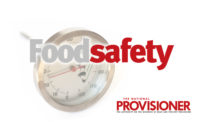Recent events, particularly the coronavirus pandemic, have heightened awareness on hygiene compliance and the need for people throughout the food supply chain to accept personal responsibility for maintaining equipment cleaning routines and sanitation protocols. Contaminant detection and checkweighing specialist Fortress Technology outlines some simple ways to create a culture that embraces food safety from start-to-end on food processing lines and the role that hygiene habits, equipment innovation, and leadership support play.
Adhering to best hygiene practices is the single thing that food plants cannot cut corners on. Across North America, standards are typically very high. However, the pressure since the global pandemic has changed the landscape for a number of food processors, with localized labor challenges and supply chain disruptions further complicating mandatory audits.
The pandemic reinforced the importance of food processors conveying confidence and having robust and proactive HACCP, GFSI/SQF, BRC and hygiene protocols in place. The challenge now is making sure that these remain aligned to evolving colleague and consumer health, safety, and wellbeing expectations.
Although price remains king when it comes to food purchasing drivers, safety has emerged as an equally critical consideration. A Deloitte report – The Future of Fresh – cites food safety as having multiple dimensions. Including listing safety for self, others, and the workers who produce food, as well as safety in terms of packaging, to prevent contamination.
Habit forming
It’s human nature. People like things to be streamlined, efficient, faster and better. Yet, taking hasty shortcuts, particularly with hygiene and consumer food safety is a risky strategy. Being careless with compliance can become a catalyst for more shortcuts. It’s not a cycle any food business would or should encourage.
Despite high levels of automation, food processing plants continue to have numerous manual touchpoints – with cleaning of manufacturing and inspection processing machinery being one.
Routine risk assessments and audits help to control the introduction of foreign material into products. External eyes provide a different perspective. Many internationally recognized audits follow set standards and provide a complete 360-degree review. A number of these information gathering audits remain hybrid, blending in-person and virtual observations. Digital evidence of all actions, from maintenance and testing of machinery to documenting hygiene checks is integral to the success of these hybrid certification models. It requires a shift in culture, where everyone up and down the hierarchy is encouraged to be a hygiene-conscious food safety champion.
Features to optimize cleaning efficacy
To help optimize cleaning processes, protocols should be verified and documented and included in staff training. As part of a validation process, regular tests, including swabs of Critical Control Points, should be scheduled.
When selecting an inspection system, care should be taken to identify equipment with an ingress protection (IP) rating appropriate to the washdown regime and water pressure being applied.
For in-process contaminant inspection equipment, look for smooth, crevice-free contact surfaces on conveyor, pipeline, and gravity systems. This is partly to ensure that no traces of product, allergens, or bacteria are left, but also to reduce the risk of cleaning agents not being fully rinsed away.
Product residues, including allergens, can be especially troublesome in pipeline systems processing liquids, semi-liquids, and slurries. Special attention should be paid to the speed that reject units can be removed, cleaned, and reassembled. Ideally, this will be easy to roll out, dismantle and clean working parts before securely reattaching to pumps.
Food processors might also consider the advantage of being able to maneuver machines around the plant. If a machine isn’t fixed to ceilings or frame it is inherently easier and quicker to deep clean. From a flexibility perspective, it also enables easy reconfiguration on upstream processing lines. With all moveable machinery, do check to see if they are balanced systems, as this mitigates the risk of the machine tipping over when being relocated. For facilities with sloped floors, adjustable casters enable easy correction of pipe angles.
Ergonomic features can also enhance workforce safety. For example, an extension pipe on the reject output helps to prevent injury during sanitation and maintenance, and electric-powered height adjustment controls can mitigate back injuries.
Listening to different perspectives and mapping out hygiene protocols collaboratively rather than reverting to hierarchies is the best way forward to create a safe food processing ecosystem.
Ultimately, good housekeeping is common sense. Most food processors are strong custodians of hygiene and safety practices. However, given the numerous critical control points in a manufacturing plant, Fortress would always advise routinely and systematically revisiting potential hygiene hazards as part of a regular risk assessment and food safety program.




Report Abusive Comment